Handicrafts
Carpets
A
carpet is a life-long investment it may well be
the single most expensive purchase during your
trip to Kashmir. Kashmiri carpets are world
renowned for two things they are hand made, never
machine made. And they are always knotted, never
tufted. It is extremely instructive to watch a
carpet being made your dealer can probably arrange
this for you.

An example of Kashmiri
embroidery.
Stretched tightly on a
frame is the warp of a carpet. The weft threads
are passed through, the 'talim' or design and
color specifications are then worked out on this:
a strand of yarn is looped through the warp and
weft, knotted and then cut. The yarn used normally
is silk, wool or silk and wool. Woollen carpets
always have a cotton base (warp & weft), silk
usually has a cotton base. Sometimes however, the
base is also silk in which case you will see that
the fringe is silk; the cost increases
proportionately. Occasionally, carpets are made on
a cotton base, mainly of woollen pile with silk
yarn used as highlights on certain motifs.
When the dealer specifies
the percentage of each yarn used, he is taking
into account the yarn used for the base too.
Therefore, a carpet with a pure silk pile may be
referred to as a '80 per cent silk carpet.' Do not
be alarmed! He is merely stating that the warp and
weft are not of silk.
A third type of yarn,
staple, also referred to as mercerized cotton, is
being mentioned here although it is by no means
traditionally Kashmiri, being a man-made fiber.
Its shine is not unlike that of silk, although in
price it is much lower than silk, but more
expensive than wool. Staple carpets are made to
fill a slot in the market customers demand a
carpet which is not unlike silk in appearance to
blend with their decor of the moment. In a couple
of years they will change their furniture and
furnishings and the staple carpet will have served
its purpose, as such a carpet is neither durable
nor increases in value with time. One important
difference between silk and staple is that pure
silk is far lighter than staple, area for area.
Thus a 3 ft x 5 ft carpet of silk will never weigh
more than 4 kg; one of staple never less than 6
kg.
Carpet weaving in Kashmir
was not originally indigenous but is thought to
have come in by way of Persia. Till today, most
designs are distinctly Persian with local
variations. One example, however, of a typically
Kashmiri design is the tree of life. Persian
design notwithstanding, any carpet woven in
Kashmir is referred to as Kashmiri. The color-way
of a carpet, and its details differentiate it from
any other carpet. And while on the subject of
color, it should be kept in mind that although the
colors of Kashmiri carpets are more subtle and
muted than elsewhere in the country, only chemical
dyes are used vegetable dyes have not been
available now for a hundred years.
The knotting of a carpet
is the most important aspect, determining its
durability and value, in addition to its design.
Basically, the more knots per square inch, the
greater its value and durability. Count the number
of knots on the reverse of a carpet in any one
square inch. It should be roughly the same as the
dealer tells you, give or take 10 knots. The most
common configurations for knots on wool or silk
Kashmiri carpets are 18x 18, 18x20,20x20, 20x22,
or 22x22. A carpet with 18x 18=360 knots per
square inch will obviously cost less than one with
22x22=484. If you are told that a carpet contains
360 knots, and your count indicates about 10 less,
it simply means that the weft has not been evenly
combed down in parts this is not a fault, and
several random checks throughout the carpet will
even out the figure to the dealer's estimate.
Also, there are single and double knotted carpets.
You can quite easily identify one from the other
on the reverse of the carpet. The effect that it
has on the pile, too, is important a double
knotted carpet has a pile that bends when you
brush it one way with your hand, and stands
upright when it is brushed in another direction. A
single knotted carpet is fluffier and more
resistant to the touch: there is no 'right' and
'wrong' side to brush it.
Why make knots at all?
you may ask. It increases the durability
dramatically than had the pile just been looped
through the base and cut. Knotted carpets are
always stiffer and firmer they don't flop or bend
as easily as do tufted carpets.
The points to keep in
mind when choosing a carpet, then, are: - whether
it has been made of silk (pile) on silk (base),
silk pile on cotton base, silk and wool on cotton
base or wool on cotton base: - the number of knots
on the reverse of the carpet: - whether one or
more line in the design has been omitted
completely in which case the pattern looks
lopsided: - whether any element in the design has
been wrongly woven so that one motif is larger or
smaller at one end than the corresponding motif at
another end, or any similar fault: - whether each
motif or element of design has clear. crisp
outlines. Blurred edges indicate a fault In the
weaving. - whether the edges of the carpet are
crooked as if It had been incorrectly mounted on
the frame, so that one end Is broader than
another.
Namdas
Far
less expensive are these colorful floor coverings
made from woollen and cotton fiber which has been
manually pressed into shape. Prices vary with the
percentage of wool, a namda containing 80 per cent
wool being more expenslve than one containing 20
per cent wool. Chain stitch embroidery in woollen
and cotton thread is worked on these rugs.
Papier Mache
At
first glance, all papier mache objects look
roughly the same, and the price differential seems
almost unreasonable. However, besides at least
three different grades of papier mache, some is
actually cardboard or wood! The idea, however. is
not to hoodwink the unwary, but to provide a
cheaper product for someone who wants the look of
papier mache.
To make papier mache,
first paper is soaked in water till it
disintegrates. It is then pounded, mixed with an
adhesive solution, shaped over moulds, and allowed
to dry and set before being painted and varnished.
Paper that has been
pounded to pulp has the smoothest finish in the
final product. When the pounding has not been so
thorough, the finish is less smooth.

Papier mache` table lamp.
The designs painted on
objects of papier mache are brightly colored. They
vary in artistry and the choice of colors, and it
is not difficult to tell a mediocre piece from an
excellent one. Gold is used on most objects,
either as the only color, or as a highlight for
certain motifs, and besides the finish of the
product, it is the quality of gold used which
determines the price. Pure gold leaf, which has an
unmistakable luster, is far more expensive than
bronze dust or gold poster paint. It also has a
much longer life and will never fade or
tarnish.
Varnish, which is applied
to the finished product, imparts a high gloss and
smoothness which in- creases with every
coat.
Cardboard, virtually
indistinguishable from papier mache, gives in
slightly when pressed firmly. Otherwise the only
difference is in the price, cardboard being
cheaper than papier mache.
Chain Stitch And Crewel
Furnishings
Because
of the high quality of embroidery done on wall
hangings and rugs, Kashmiri crewel work is in
great demand throughout the world.
Chain stitch, be it in
wool, silk or cotton, is done by hook rather than
by needle. The hook is referred to as ari, and
quality for quality, hook work covers a much
larger area than needle work in the same amount of
time.

Workers finish a
crewel-embroidered fabric.
All the embroidery is
executed on white cotton fabric, pre-shrunk by the
manufacturers. The intrinsic worth of each piece
lies in the size of the stitches and in the yarn
used. Tiny stitches are used to cover the entire
area the figure or motifs are worked in striking
colors; the background in a single color, made up
of a series of coin sized concentric circles which
impart dynamism and a sense of movement to the
design. Stitches ought to be small, even sized and
neat. The background fabric should not be visible
through the stitches.
Crewel is basically
similar to chain stitch. It is also chain stitch
done on a white background, but here the motifs,
mainly stylized flowers, do not cover the entire
surface, and the background is not embroidered
upon. Wool is almost invariably used in crewel
work and colorways are not as elaborate as in
chain stitch, two or three colors being the norm
here. This fabric is available in bolts, and is
sold by the length. They make excellent household
furnishings being hand or machine washable.
Saffron, Walnuts,
Almonds, Honey
Pampore,
outside Srinagar, is the only place in the world
besides Spain where saffron is grown. The crocus
sativus which blooms for a brief month in the
year, has six golden stamens and one crimson one.
It is the crimson stamen which when collected and
dried is referred to as the most expensive spice
in the world. Sealed jars of this spice, with the
government laboratory's stamp of approval, are
available all over Srinagar. When buying loose
saffron, sampling one strand is enough, for the
flavor and fragrance of saffron are unmistakable.
The climate of Kashmir is
ideal for walnut and almond trees which grow here
in abundance. Natural honey too, is a produce of
the apiaries which abound in the state.
Silks, Tweeds
Sericulture
and tweed weaving are important industries in
Kashmir, with departments of the state government
closely monitoring the process. Interestingly,
just as little or no raw material for tweed comes
from Kashmir, almost no weaving and printing of
silk is done in the state. However, the cocoon
reared in Kashmir is of a superior quality,
yielding an extremely fine fiber, and any silk
woven from this thread becomes known, quite
legitimately, as Kashmiri silk. The fineness of
the yarn lends itself particularly well to the
weaves known as chinon and crepe de chine. in
addition to the universally recognized silk weave.
The cost of silk fabric goes up with its weight
per meter, 30 grams being at one end of the scale
and 80 grams at the other. Fabric is generally
sold by the length as saris and its lightness and
softness lends itself well to shirting and dress
material.
Tweed on the other hand
is woven in Kashmir with pure, never blended, wool
. The resultant fabric, made with imported
know-how, compares favorably with the best in the
world. It is available by the length; occasionally
as ready to wear garments.
Pherans
This
garment, somewhere between a coat and a cloak, is
eminently suited to the Kashmiri way of life,
being loose enough to admit the inevitable brazier
of live coals which is carried around in much the
same way as a hot water bottle. Men's pherans are
always made of tweed or coarse wool: women's
pherans, somewhat more stylized. are most commonly
made of raffel. with splashes of ari or hook
embroidery at the throat, cuffs and edges. The
quality of embroidery and thickness of the raffel
determines the price.

The richly embroidered
'neck' of a pheran.
Shawls
There
are three fibers from which Kashmiri shawls are
made wool, pashmina and shahtoosh. The prices of
the three cannot be compared woollen shawls being
within the reach of the most modest budget, and
shahtoosh being a once-in-a-lifetime
purchase.
Woollen shawls are
popular because of the embroidery worked on them
which is special to Kashmir. Both embroidery and
the type of wool used causes differences in the
price.
Wool woven in Kashmir is
known as raffel and is always 100 per cent pure.
Sometimes blends from other parts of the country
are used and Kashmiri embroidery is worked on
them. These blends contain either cashmilon,
cotton, or a mixture of both. Many kinds of
embroidery are worked on shawls 'sozni' or
needlework is generally done in a panel along the
sides of the shawl. Motifs, usually abstract
designs or stylized paisleys and flowers are
worked in one or two, occasionally three colors,
all subdued. The stitch employed is not unlike
stem stitch, and only the outline of the design is
embroidered. The fineness of the workmanship and
the amount of embroidery determines the value of
the shawl.
Sozni is often done so
skillfully that the motif appears on both sides of
the shawl each side having a different colorway.
This naturally has a bearing on the cost.
Another type of needle
embroidery is popularly known as 'papier mache'
work because of the design and the style in which
it is executed. This is done either in broad
panels on either side of the breadth of a shawl,
or covering the entire surface of a stole. Flowers
and leaves are worked in satin stitch in bright
colors such as those of papier mache and each
motif is then outlined in black.
A third type of
embroidery is ari or hook embroidery; motifs here
are the well-known flower design finely worked in
concentric rings of chain stitch.
Pashmina is unmistakable
for its softness. Pashmina yarn is spun from the
hair of the ibex found at 14,000 ft above sea
level. Although pure pashmina is expensive, the
cost is sometimes brought down by blending it with
rabbit fur or with wool. It is on. pashmina shawls
that Kashmir's most exquisite embroidery is
worked, sometimes covering the entire surface,
earning it the name of 'jamawar'. A jamavar shawl
can, by virtue of the embroidery, increase the
value of a shawl three-fold. Not all pashmina
shawls, however, have such lavish embroidery some
are embroidered on a narrow panel bordering the
four sides of a shawl, others in narrow strips
running diagonally through the shawl.
A second, less frequently
seen weave, done only on pashmina, covers the
surface with tiny lozenge shaped squares, earning
it the delightful name of 'chashme bulbul,' or eye
of the bulbul. As this weave is a masterpiece of
the weaver's art, it is normally not embroidered
upon.
Shahtoosh, the legendary
'ring shawl' is incredible for its tightness,
softness and warmth. The astronomical price it
commands in the market is due to the scarcity of
the raw material. High in the plateaus of Tibet
and the eastern part of Ladakh, at an altitude of
above 5,000 meters, roam Pantholops Hodgsoni, or
Tibetan antelope. During grazing, a few strands of
the downy hair from the throat are shed and it is
these which are painstakingly collected until
there are enough for a shawl.
Yarn is spun either from
shahtoosh alone, or with pashmina, bringing down
the cost somewhat. In the case of pure shahtoosh
too, there are many qualities the yarn can be spun
so skillfully as to resemble a strand of silk. Not
only are shawls made from such fine yarn extremely
expensive, they can only be loosely woven and are
too flimsy for embroidery to be done on them.
Unlike woollen and pashmina shawls, shahtoosh is
seldom dyed that would be rather like dyeing gold!
Its natural color is mousy brown, and it is, at
the most, sparsely embroidered.
Basketry
Willow
rushes that grow plentifully in marshes and lakes
in Kashmir are used to make charmingly quaint
objects, ranging from shopping baskets and
lampshades to tables and chairs, all generally
inexpensive. To increase their life-span,
unvarnished products should be chosen and
frequently sprayed with water, particularly in
hot, dry climates, to prevent them becoming
brittle.

A local crafts shop in
the old city.
Walnut Wood
Kashmir
is the only part of India where the walnut tree
grows. Its color, grains and inherent sheen are
unique and unmistakable, and the carving and
fretwork that is done on this wood is of a very
superior quality.
There are two types of
walnut trees the fruit bearing species whose wood
is so well-known, and one which bears no fruit and
is locally known as 'zangul.' Zangul has none of
the beauty of walnut wood, being much less strong
and possessing no grain, and will not be dealt
with here.
The walnut root is almost
black, and the grain here is much more pronounced
than the wood of the trunk which is lighter in
color. The branches have the lightest color, being
almost blonde, and have no noticeable grain. The
intrinsic worth of the wood from each part of the
tree differs that from the root being the most
expensive, and the branches having the lowest
value.
Often, when a tree is
sawn, a marked difference in color is noticed
between one part of the trunk and the other. This
is overcome by dyeing the lighter part to the
exact shade of the darker. Dye is prepared from
the outer covering of the fruit of the walnut.
Sometimes small objects of utility trays, bowls
and the like are left with the natural variation
of color for customers who find it appealing.
As the grain on any wood
is its distinguishing feature, when a walnut tree
is sawn, the prime motive is to display to full
advantage its densely packed rings. After a tree
is felled, the ideal period for which it should be
left to season is two years. The advantage of
seasoning is that molecules of moisture which are
entrapped in the wood of the live tree evaporate
so that shrinking takes place before the wood is
cut and fashioned into objects for sale.
When a dealer buys a
whole tree and leaves it to season, a part of his
capital becomes blocked for that period and this
will naturally be reflected in the cost of his
product. A cheaper product, on the other hand, is
liable to warp, or in case it is taken to warmer
climes, will crack or shrink.
Knots on any tree are
natural and inevitable, but as their appearance is
commonly thought to mar the beauty and smoothness
of the finished product, knots are usually
concealed skillfully in the sawing, as it is
difficult, though not impossible, to mask them
while carving.
Carving is a
demonstration o. the carver's skill, and walnut is
eminently suitable for this, being one of the
strongest varieties of wood. There are several
varieties of carving deep carving, usually with
dragon and lotus flower motifs, two inches deep or
more; shallow carving, half an inch deep done all
over the flat surface; open or lattice work,
usually depicting the chinar motif: and most
popularly, semi carving, which is a thin panel
along the rim of the surface, with perhaps a
center motif. The advantage of semi-carving is
that it allows the grain of the wood to be
displayed, together with the carver's skill.
Naturally deep carving with all the skill and
labor required, is the most expensive.
Wax polishing brings out
the sheen inherent in walnut wood, and is by far
the most popular finish. Because varnish obscures
the grain of the wood and alters its hue, it is
seldom used.
When choosing objects
made from walnut wood, keep in mind that the type
of carving and part of the tree used will affect
the price.
The optimum thickness for
items of furniture is one inch. Anything less than
that will naturally be less expensive as it
shortens the life of the object. Furniture which
makes exclusive use of walnut wood will naturally
cost more than articles in which zangul has been
used for surfaces normally hidden from view.
Copper and Silverware
The
old city abounds with shops where objects of
copper line the walls, the floor and even the
ceiling, made generally for the local market.
Craftsmen can often be seen engraving objects of
household utility samovars, bowls, plates and
trays. Floral, stylized, geometric, leaf and
sometimes calligraphic motifs are engraved or
embossed on copper, and occasionally silver, to
cover the entire surface with intricate designs
which are then oxidized, the better to stand out
from the background. The work, known as 'naqash',
determines the price of the object, as does the
weight.
| 


















No one has commented yet. Be the first!